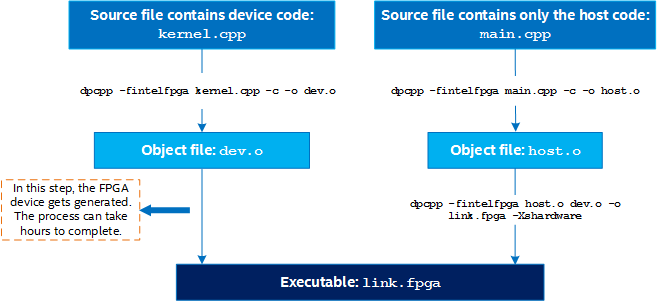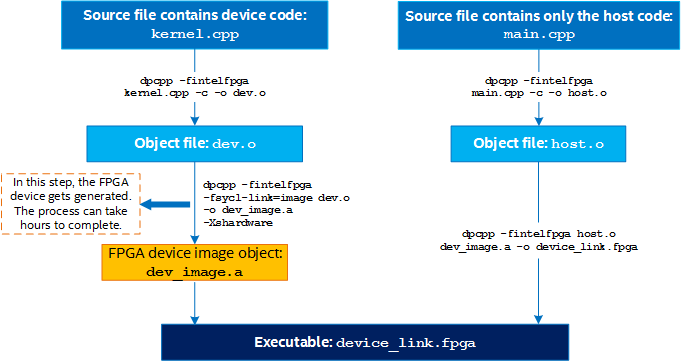A newer version of this document is available. Customers should click here to go to the newest version.
Visible to Intel only — GUID: GUID-19B1C305-ED75-4BEC-BF55-58FEEDCE70C4
Visible to Intel only — GUID: GUID-19B1C305-ED75-4BEC-BF55-58FEEDCE70C4
Fast Recompile for FPGA
The Intel® oneAPI DPC++/C++ Compiler supports only the ahead-of-time (AoT) compilation for FPGA hardware, which means that an FPGA device image is generated at compile time. The FPGA device image generation process can take hours to complete. If you make a change exclusive to the host code, then recompile only your host code by reusing the existing FPGA device image and circumventing the time-consuming device compilation process.
The Intel® oneAPI DPC++/C++ Compiler provides the following mechanisms to separate device code and host code compilation:
Passing the -reuse-exe=<exe_name> flag to instruct the compiler to attempt to reuse the existing FPGA device image.
Separating the host and device code into separate files. When a code change applies only to host-only files, the FPGA device image is not regenerated.
Separating the device code using the compiler option -fsycl-device-code-split.
The following sections explain these two mechanisms in detail.
Using the -reuse-exe Flag
If the device code and options affecting the device have not changed since the previous compilation, passing the -reuse-exe=<exe_name> flag instructs the compiler to extract the compiled FPGA hardware image from the existing executable and package it into the new executable, saving the device compilation time.
Sample use:
# Initial compilation icpx -fsycl -fintelfpga -Xshardware <files.cpp> -o out.fpga
The initial compilation generates an FPGA device image, which takes several hours. Suppose you now make some changes to the host code.
# Subsequent recompilation icpx -fsycl <files.cpp> -o out.fpga -reuse-exe=out.fpga -Xshardware -fintelfpga
One of the following actions are taken by the command:
If the out.fpga file does not exist, the -reuse-exe flag is ignored, and the FPGA device image is regenerated. This is always the case the first time you compile a project.
If the out.fpga file is found, the compiler verifies no change that affects the FPGA device code is made since the last compilation. If no change is detected in the device code, the compiler then reuses the existing FPGA device image and recompiles only the host code. The recompilation process takes a few minutes to complete.
If the out.fpga file is found, but the compiler cannot prove that the FPGA device code will yield a result identical to the last compilation, a warning is printed, and the FPGA device code is fully recompiled. Since the compiler checks must be conservative, spurious recompilations can sometimes occur when using the -reuse-exe flag.
Using the Device Link Method
Suppose the program is separated into two files, main.cpp and kernel.cpp, where only the kernel.cpp file contains the device code.
In the normal compilation process, FPGA device image generation happens at link time.
# normal compile command icpx -fsycl -fintelfpga -Xshardware main.cpp kernel.cpp -o link.fpga
As a result, any change to either the main.cpp or kernel.cpp triggers the regeneration of an FPGA hardware image.
The following graph depicts this compilation process:

If you want to iterate on the host code and avoid a long compile time for your FPGA device, consider using a device link to separate the device and host compilation:
# device link command icpx -fsycl -fintelfpga -fsycl-link=image <input files> [options]
The compilation is a three-step process as listed in the following:
Compile the device code.
icpx -fsycl -fintelfpga -Xshardware -fsycl-link=image kernel.cpp -o dev_image.a
Input files must include all files that contain the device code. This step might take several hours to complete.
Compile the host code.
icpx -fsycl -fintelfpga main.cpp -c -o host.o
Input files should include all source files that contain only the host code. These files must not contain any source code that executes on the device but may contain setup and tear-down code, for example, parsing command-line options and reporting results. This step takes seconds to complete.
Create the device link.
icpx -fsycl -fintelfpga host.o dev_image.a -o fast_recompile.fpga
This step takes seconds to complete. The input should include one or more host object files (.o) and exactly one device image file (.a). When linking a static library (.a file), always include the static library after its use. Otherwise, the library’s functions are discarded. For additional information about static library linking, refer to Library order in static linking.
The following diagram illustrates the device link process:

Refer to the fast_recompile tutorial in the Intel® oneAPI Samples Browser for an example using the device link method.
Using the -fsycl-device-code-split[=value] Option
When you use the -fsycl-device-code-split[=value] option, the compiler compiles each split partition as if targeting its own device. This option supports the following modes:
auto: This is the default mode and the same as the -fsycl-device-code-split option without any value. The compiler uses a heuristic to select the best way of splitting device code.
off: Creates a single module for all kernels.
per_kernel: Creates a separate device code module for each kernel. Each device code module contains a kernel and dependencies, such as called functions and user variables.
per_source: Creates a separate device code module for each source (translation unit). Each device code module contains a bunch of kernels grouped on a per-source basis and all their dependencies, such as all used variables and called functions, including the SYCL_EXTERNAL macro-marked functions from other translation units.
For additional information about this option, refer to the fsycl-device-code-split topic in Intel® oneAPI DPC++/C++ Compiler Developer Guide and Reference.
Which Mechanism to Use?
Of the mechanisms described above, the -reuse-exe flag mechanism is easier to use than the device link mechanism. The flag also allows you to keep your host and device code as a single source, which is preferred for small programs. For larger and more complex projects, the device link method gives you more control over the compiler’s behavior.
However, there are some drawbacks of the -reuse-exe flag when compared to compiling separate files. Consider the following when using the -reuse-exe flag:
The compiler must spend time partially recompiling and then analyzing the device code to ensure that it is unchanged. This takes several minutes for larger designs. Compiling separate files does not incur this extra time.
You might occasionally encounter a false positive where the compiler incorrectly believes it must recompile your device code. In a single source file, the device and host code are coupled, so certain changes to the host code can change the compiler’s view of the device code. The compiler always behaves conservatively and triggers a full recompilation if it cannot prove that reusing the previous FPGA binary is safe. Compiling separate files eliminates this possibility.